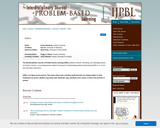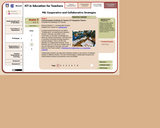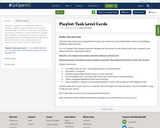
Students generate anatonmy ideasfor the creation of Valentine's Day bio-tines.
- Subject:
- Life Science
- Material Type:
- Lesson Plan
- Author:
- Kathy Bosiak
- Date Added:
- 11/28/2019

Students generate anatonmy ideasfor the creation of Valentine's Day bio-tines.

This is a unit of study whose competency is to Manage student project-based learning activities in a technology-enhanced environment to support collaboration.

Design and build a sleigh using a WeDo kit that will pull a specific measured weight.

In this session you will learn about great multicultural literature selections that work well with STEM projects for elementary students. It is essential that we purposefully select and include multicultural resources with our students, and engaging them with STEM tasks deepens the learning. I will share ideas for the projects and materials that may be used to create the products.
Presentation Links:
https://docs.google.com/presentation/d/1WpSVWK75DdM_EoCxhCKkd6ULoL5te3FmfY1VnSz6Bf0/edit#slide=id.p
https://static.sched.com/hosted_files/k5engineers2020/65/STEM%20Fiction%20Problem%20Solving%20%281%29%20-%20Mary%20Carrington.pdf

The Interdisciplinary Journal of Problem-based Learning (IJPBL) publishes relevant, interesting, and challenging articles of research, analysis, or promising practice related to all aspects of implementing problem-based learning (PBL) in K–12 and post-secondary classrooms.

In this session, attendees will learn how to lead students through the planning and development process of design challenges. Attendees will develop an understanding of the various components and stakeholders that can be brought into these challenges so that students have a well-rounded authentic learning experience.
Link to presentation slides:
https://docs.google.com/presentation/d/1mcsbNZUEE07uCXl5HByCw3NEy7kIDcpBr5UQt3dmeZw/edit#slide=id.g714aceb6c2_0_0

This is a great lesson plan to use to keep you on track. It includes what your principals/evaluators are looking for during observations, and even gives a section for you to reflect on your lesson. It can also be utilized by subs if written correctly.

This is a great lesson plan to use to keep you on track. It includes what your principals/evaluators are looking for during observations, and even gives a section for you to reflect on your lesson. It can also be utilized by subs if written correctly.

This is a great lesson plan to use to keep you on track. It includes what your principals/evaluators are looking for during observations, and even gives a section for you to reflect on your lesson. It can also be utilized by subs if written correctly.

This is a great lesson plan to use to keep you on track. It includes what your principals/evaluators are looking for during observations, and even gives a section for you to reflect on your lesson. It can also be utilized by subs if written correctly.

A unit of study for teachers to provide participants with clear directions so that they can continue to design a PBL project.

A playlist
-is a sequence of activities for students to complete.
-might be assigned during one class period, over a few days, or even for an entire unit.
-can be based on one skill or standard in a course or based on multiple skills, standards, or disciplines.
This resource includes a sample playlist based on a single standard in high school ELA as well as links to other sample playlists and resources across content areas and grade levels.

This set of slides is intended to provide you with a brief overview of the key elements of high-quality Project Based Learning. It includes links to other PBL resources and examples. This set of slides is best reviewed with a group of educators ready to learn more about PBL so they can make the learning more engaging and relevant for students. Enjoy!

This checklist helps teachers prepare for project presentations before they start.

This online learning module will explore the following learning targets: 1: Understand the foundations of problem-based learning2: Learn the phases of a problem-based learning module3: Understand the shifts of teachers and students in a problem-based learning classroom

Learn how to increase engagement and retention in your classroom. Edutopia's professional development PBL teaching module is designed for either a two- to three-hour class or session or a one- to two-day workshop, and is divided into two parts.Part one, Guided Process, designed to give participants a brief introduction to PBL, answers the questions "What is PBL about?" "Why is PBL important?" and "How does PBL work?" The Guided Process also includes the Teaching About PBL section as well as a PowerPoint presentation (including presenter notes), which can be shown directly from the Web site or can be downloaded for use as a stand-alone slide show.Part two, Group Participation, assigns readings and activities for experiential PBL. Ideally, the tasks will be accomplished using group collaboration and with the use of technology.

This is a tool teachers can use to design high quality PBL projects, including how to ensure they have a strong connection to curricular standards and success skills, they are authentic per things students care about, they provide students with choice and voice during the project, assessments and scaffolding are intentional and personalized for each student, time is dedicated for student reflection and revision, and the project has a public audience.

This contract can be used by a project team to agree upon about how they will work together.

Project walls are bulletin boards or wall spaces that guide learning and project management throughout the project.

In this session, you'll see actual, real-life examples of engineering / design thinking projects in classrooms just like yours. We will explore examples all the way from kindergarten through advanced high school math- with teacher-created materials and videos clearly showing the positive impacts on student thinking and learning.
Link to presentation slides:
https://docs.google.com/presentation/d/123d4vBKJZI6P7y7tF40IWhQyiUB94G6Bys1HXOv5gSY/edit#slide=id.g35f391192_04